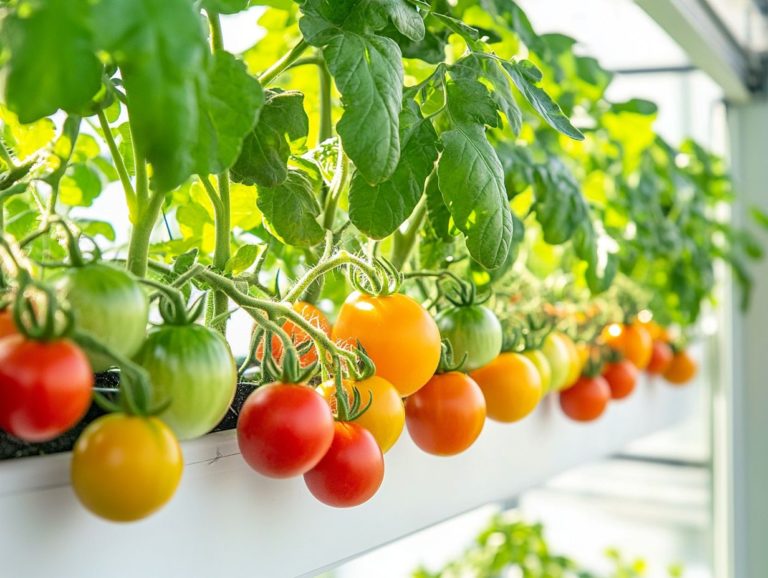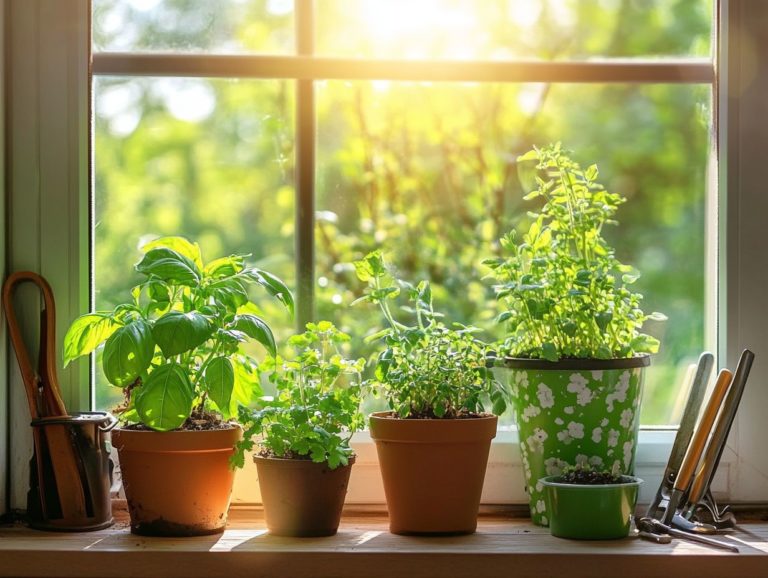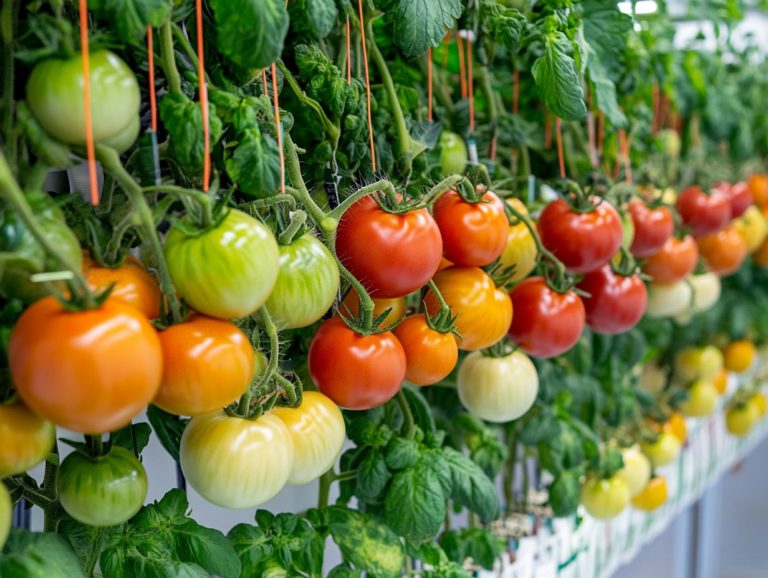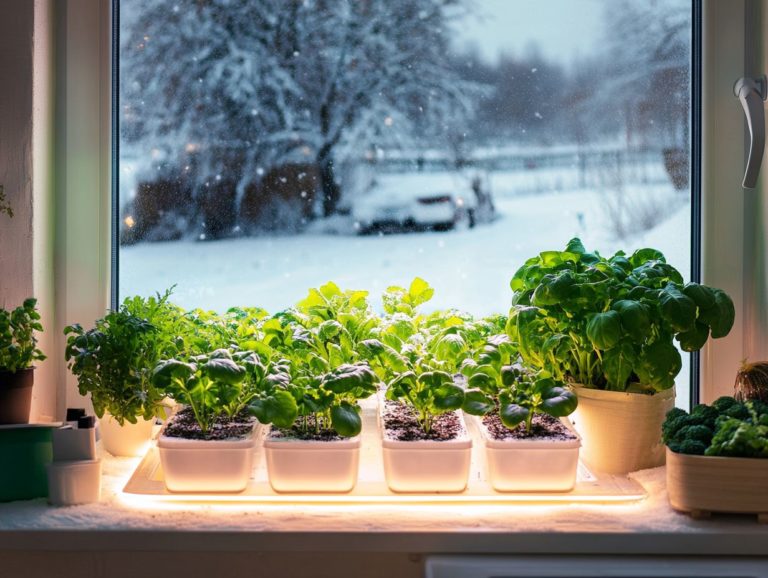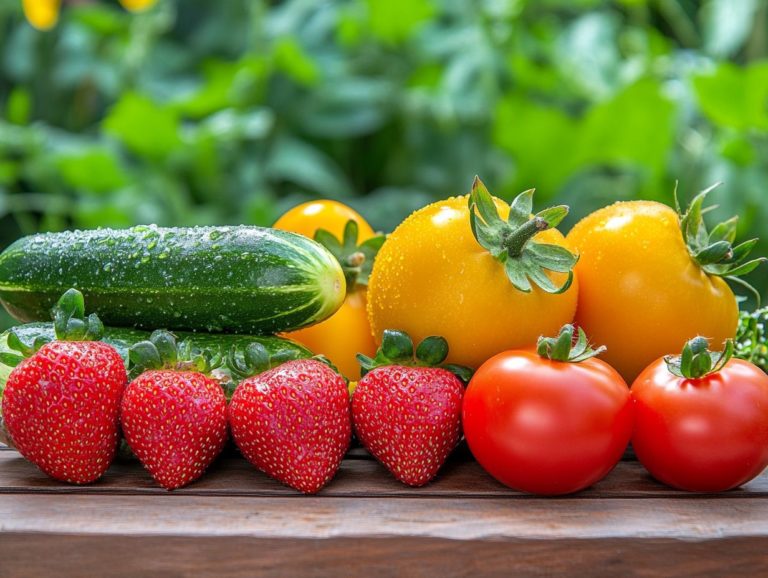“How to Grow Microgreens Hydroponically”
Microgreens are tiny, packed with nutrients greens that deliver both flavor and health benefits in an impressive package.
Growing them hydroponically is an innovative way to cultivate these little powerhouses without soil. This method is especially useful in container farming, making it ideal for urban gardeners.
This comprehensive guide will equip you with the essentials of hydroponic microgreens from selecting the right seeds and materials to a detailed, step-by-step growing process.
You ll also find invaluable harvesting tips and creative suggestions for incorporating these vibrant greens into your culinary creations, enhancing their flavor.
Get ready to explore the exciting world of hydroponic gardening!
Contents
Key Takeaways:
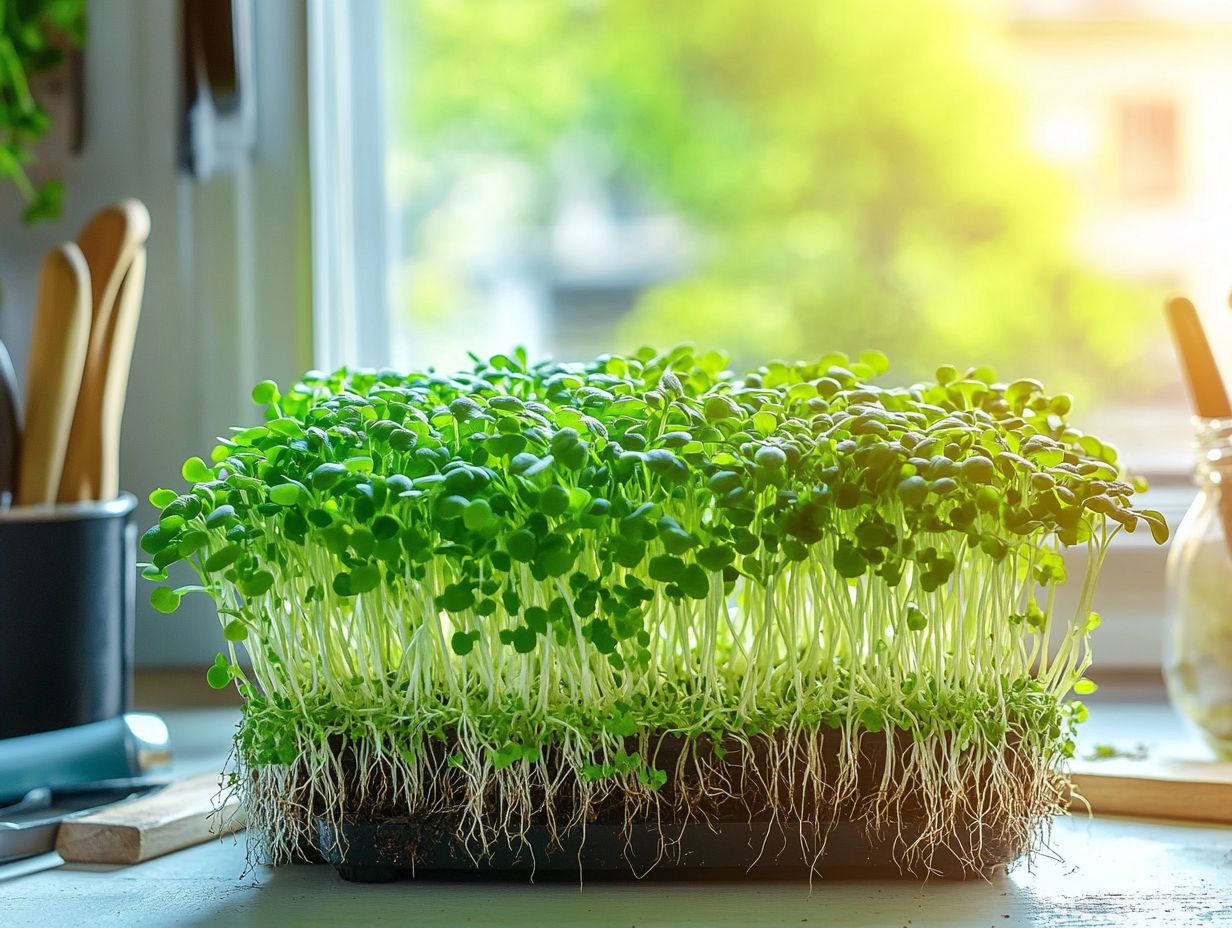
- Microgreens are young, packed with nutrients plants that can be easily grown hydroponically in limited space with minimal water.
- Hydroponic microgreens grow quickly, yield more, and face fewer pests and diseases.
- To successfully grow hydroponic microgreens, you need the right materials and equipment, carefully chosen seeds, proper planting and care techniques, and knowledge on harvesting and troubleshooting common issues.
What are Microgreens?
Microgreens are young, edible greens you can harvest just after the first leaves have developed, typically within 7 to 21 days of germination. These nutrient-dense plants think radish, broccoli, and sunflower have surged in popularity thanks to urban farming and sustainable practices.
They re not just a trend; they ve become a staple in high-end restaurants and local food systems in cities like Charleston and Hamilton Horne, supported by innovative companies like Freight Farms.
Microgreens thrive in various growing conditions and require minimal space, making them the perfect fit for urban environments where traditional agriculture might not be an option.
Their appeal goes beyond just vibrant flavors and stunning colors; they re packed with vitamins and antioxidants, making them a smart choice for health-conscious consumers.
With the rising interest in localized and sustainable food sources, these tiny greens are becoming critical to local economies. They foster community engagement and inspire aspiring gardeners to grow their own. As more people prioritize nutrition and sustainability, the demand for these versatile crops continues to climb, cementing their place in today s culinary and agricultural scenes.
Benefits of Growing Hydroponically
Growing microgreens hydroponically presents an array of advantages that you re sure to appreciate. It allows for efficient use of space and water, accelerates crop production, and enables cultivation in a variety of urban settings.
This innovative farming technique employs a nutrient solution to deliver essential elements directly to the plants, promoting rapid growth while minimizing the reliance on traditional soil-based methods.
Not only does this approach optimize water usage often consuming up to 90% less than conventional farming but it also results in significantly higher production levels per square foot. By aligning closely with local demand for fresh produce, hydroponic systems cater to your growing preference for sustainably sourced food.
The reduction in transportation emissions, along with lower pesticide usage, greatly enhances eco-friendly practices in urban farming and supports sustainable agriculture.
As cities expand and the demand for sustainable agriculture increases, hydroponics emerges as a viable solution, boosting local resilience while ensuring you have access to nutritious food options.
Getting Started with Hydroponic Microgreens
Embarking on the journey of cultivating hydroponic microgreens demands a keen understanding of the essential materials and equipment that are pivotal in creating optimal growing conditions. You must carefully select the right growing medium whether it s coco coir or substrate mats as well as diligently monitor the pH level of your nutrient solution.
Each of these components plays a significant role in the germination process, contributing to the cultivation techniques that enhance the overall vitality of your microgreens.
Want to learn how to easily grow your own microgreens? Let’s dive into the essentials!
Materials and Equipment Needed
You need essential items like growing trays, a reliable pH control kit, and various growing mediums such as hemp mats and coco coir. Each of these plays a vital role in the plants health during germination.
Proper lighting is crucial. LED grow lights mimic sunlight and boost growth.
A timer can automate light cycles. This consistency helps your plants thrive.
A humidity dome helps keep moisture. You can find supplies at local garden centers or online.
Invest in a nutrient solution for delicious microgreens. A spray bottle for gentle watering will elevate your care routine and prevent over-saturation, ensuring your plants flourish beautifully.
Choosing the Right Seeds
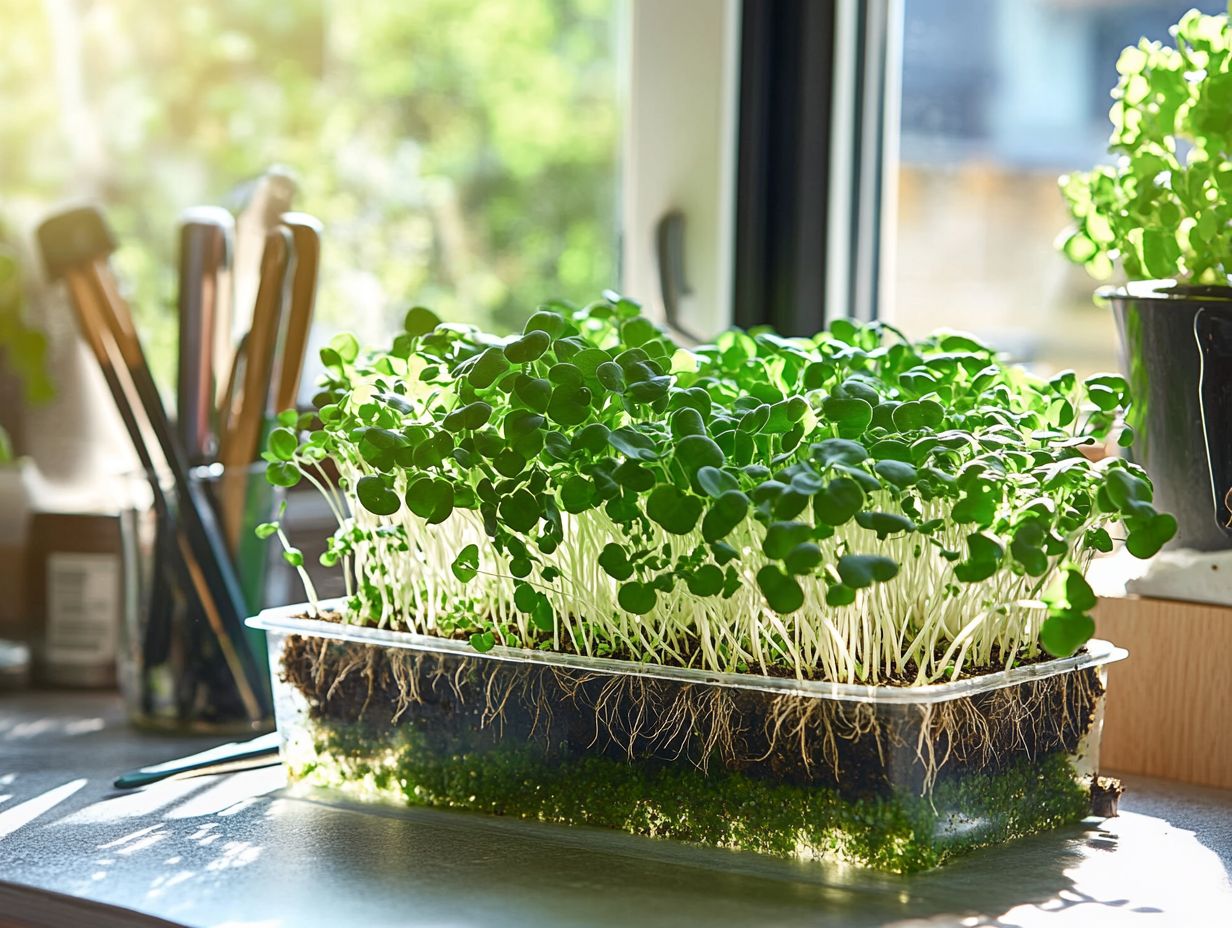
Choose the right microgreen seeds for great flavors. Popular choices include radish, broccoli, and sunflower seeds.
Choosing the right varieties matters. They affect the taste and nutrition of your produce.
Use organic seeds. This ensures your plants grow without harmful chemicals.
Emphasizing local sourcing caters to regional preferences and supports community sustainability.
Step-by-Step Guide to Growing Hydroponic Microgreens
Growing hydroponic microgreens takes a systematic approach. Focus on ideal conditions and diligent care.
Preparing the Growing Container
Prepare your growing container carefully. This step creates a stable environment for your plants.
-
First, choose trays that fit your space. Trays with drainage holes prevent waterlogging.
-
Next, lay down a substrate mat designed for microgreens. This gives your seeds excellent support while maintaining moisture.
-
Mix the nutrient solution by following the recommended ratios. This ensures your plants receive essential minerals and vitamins.
-
Incorporate adequate drainage in your container. It prevents root rot and creates a healthier environment.
Planting and Caring for Microgreens
Once you’ve prepared the container, it’s time to dive into the next phase: planting the microgreen seeds and providing them with the care they deserve for successful germination. Proper light exposure and the right nutrient solution are key to creating an environment that maximizes the health benefits of your microgreens.
Start by sprinkling the seeds evenly across the soil’s surface, maintaining about a quarter-inch distance from each other. This distance gives them the room they need to flourish without overcrowding. Lightly press the seeds down to ensure good contact with the soil. Then, cover them with a thin layer of soil, roughly 1/8 inch deep.
Check the soil moisture regularly. If it feels dry, mist it lightly. Consistent light is vital, so position the container where it can bask in 12-16 hours of indirect sunlight each day, or consider using grow lights if necessary.
Adjusting the nutrient solution to meet your microgreens’ needs will help you grow vibrant, nutrient-packed plants, significantly enhancing their health benefits.
Harvesting and Using Hydroponic Microgreens
The harvest process for hydroponic microgreens is a pivotal phase that significantly impacts both the quality of your produce and its market value. Understanding the best time and techniques for harvesting these nutrient-dense greens can elevate their flavor and freshness, ultimately attracting customers eager to invest in premium-quality microgreens.
When and How to Harvest
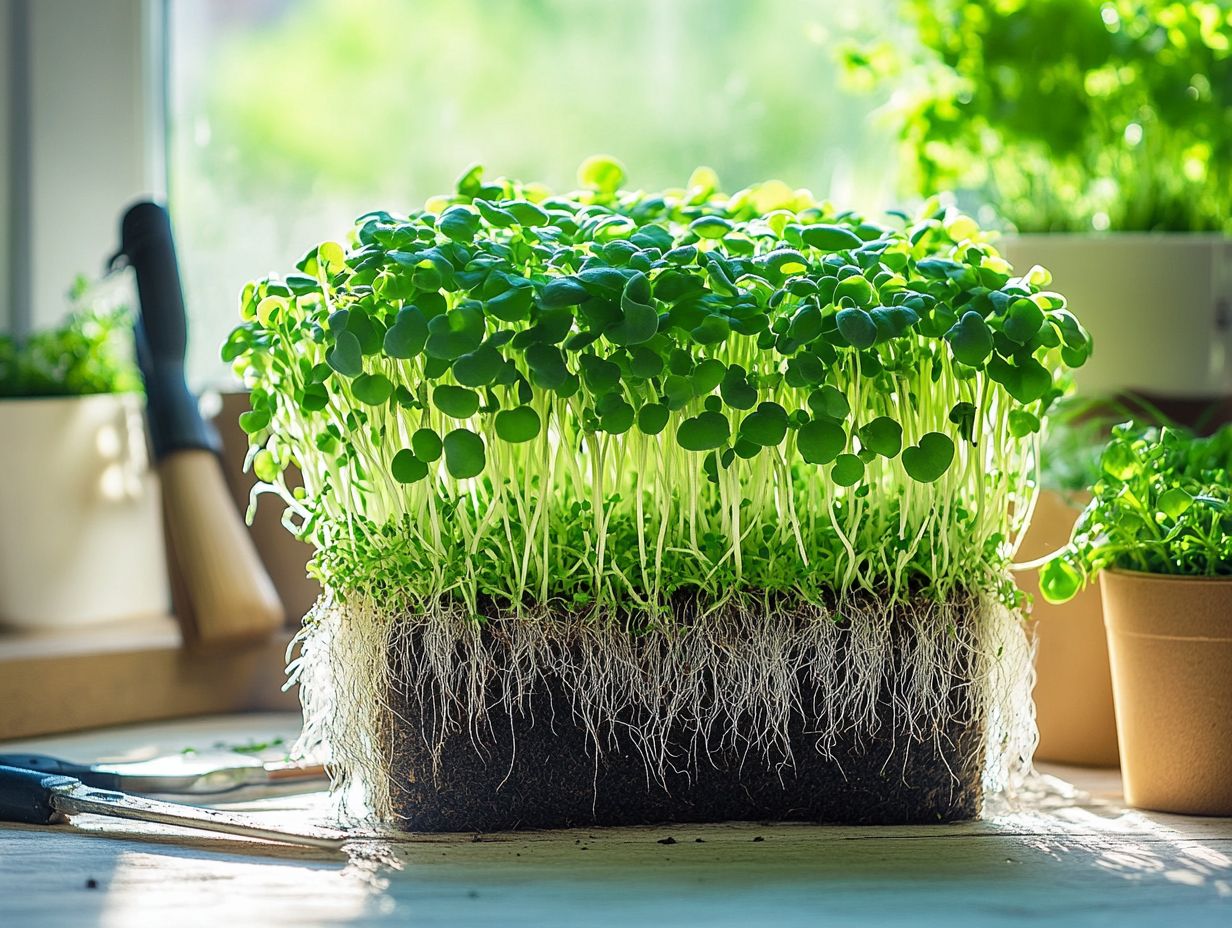
Harvesting microgreens at the perfect moment is key to unlocking their full nutrient density and flavor profile, typically right when the first true leaves emerge. Use clean, sharp scissors to snip the microgreens just above the growing medium, ensuring you disturb the root system as little as possible.
Timing may vary slightly depending on the variety; for instance, basil and arugula are often ready in about 14 days, while pea shoots might take closer to 21 days. After cutting, handle the greens with care.
Gently rinse them in cold water to remove any soil or debris, then pat them dry to avoid excess moisture that could lead to spoilage.
For optimal storage, place them in breathable containers in the refrigerator. This helps maintain their crispness and vibrant color, ensuring they reach you in peak freshness.
Ways to Incorporate Microgreens into Meals
Incorporating microgreens into your meals offers a versatile approach to enhancing flavor, boosting nutrition, and supporting food security within local economies. Whether you use them as a garnish, toss them into salads, or blend them into smoothies, microgreens can transform everyday dishes into gourmet experiences that appeal to health-conscious diners.
With their vibrant array of flavors and textures, these tiny greens can elevate everything from your breakfast omelets to your evening stir-fries. For example, a handful of peppery arugula microgreens can infuse a zesty kick into simple avocado toast, while sweet basil microgreens deliver a fresh burst on homemade pizzas.
Integrating them into your meals not only amplifies nutritional value thanks to their rich content of vitamins and antioxidants but also champions sustainable agriculture by supporting local farmers. Experimenting with microgreens in various recipes sparks creativity in the kitchen and contributes to a more nutrient-dense diet you can feel good about.
Troubleshooting Common Issues
Troubleshooting common issues in hydroponic microgreens is essential to maintain optimal growing conditions and ensure a successful crop.
By grasping the nuances of factors such as pH level fluctuations, inadequate light exposure, and improper nutrient solutions, you can adopt innovative farming techniques that not only address potential problems but also promote eco-friendly practices.
Try growing microgreens at home today for a boost in nutrition and flavor!
Preventing and Solving Problems
To prevent and solve issues in your microgreens journey, take an active approach. Focus on the overall health of your plants to minimize setbacks.
Implement sustainable solutions like organic pest management and consistent monitoring. This significantly reduces the chances of encountering problems in your hydroponic garden.
Strengthen your greens by using crop rotation and companion planting. Regularly inspect your plants for early signs of pests or disease to enable quick action.
Control humidity and temperature to create a less inviting environment for harmful agents. Using natural predators and beneficial microorganisms promotes a thriving ecosystem without relying on synthetic chemicals.
Frequently Asked Questions
What are microgreens?
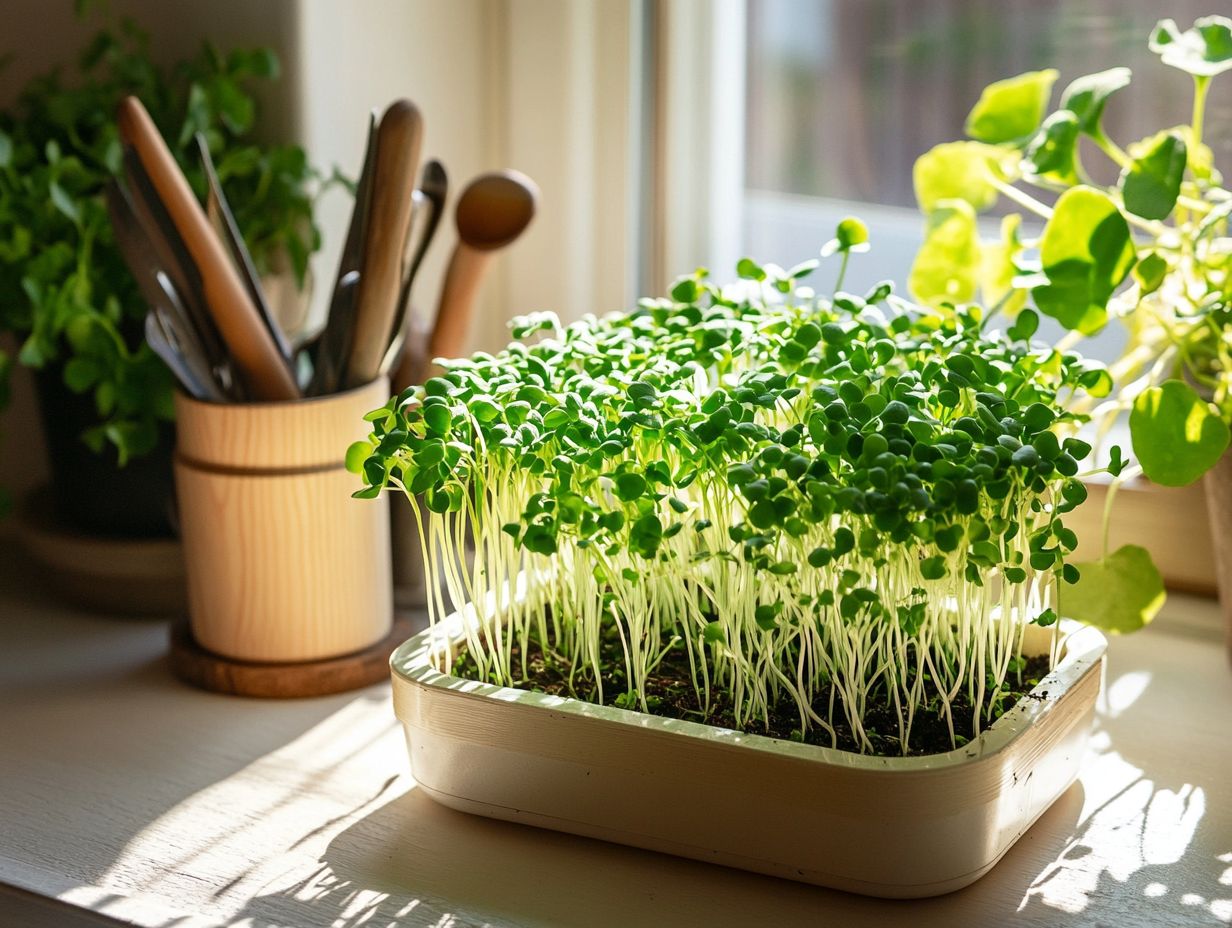
Microgreens are young, edible plants harvested very early. Packed with nutrients, they add a healthy touch to meals and can also be used as garnishes.
What is hydroponic growing?
Hydroponic growing means cultivating plants without soil. Instead, plants grow in nutrient-enriched water, allowing for efficient growth.
What are the benefits of growing microgreens hydroponically?
This method offers faster growth, higher yields, and a cleaner environment. You can also grow them year-round and control nutrient levels for better plant health.
What supplies do I need to grow microgreens hydroponically?
For hydroponic microgreens, you’ll need a container, growing medium, seeds, water, and light. Optional items include a pH meter and nutrient solution.
How do I start growing microgreens hydroponically?
Choose a container, fill it with growing medium, and soak the seeds overnight. Spread them evenly on the medium and keep them moist in a warm, well-lit area.
Can I grow microgreens hydroponically indoors?
Absolutely! Hydroponic growing is perfect for indoors. It allows year-round growth in small spaces just ensure adequate light and maintain cleanliness.

